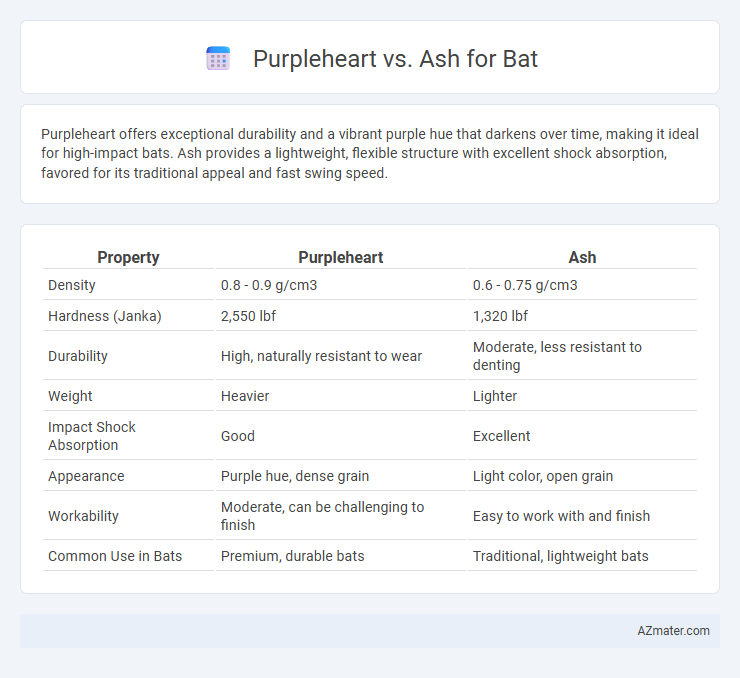Purpleheart offers exceptional durability and a vibrant purple hue that darkens over time, making it ideal for high-impact bats. Ash provides a lightweight, flexible structure with excellent shock absorption, favored for its traditional appeal and fast swing speed.
Table of Comparison
| Property | Purpleheart | Ash |
|---|---|---|
| Density | 0.8 - 0.9 g/cm3 | 0.6 - 0.75 g/cm3 |
| Hardness (Janka) | 2,550 lbf | 1,320 lbf |
| Durability | High, naturally resistant to wear | Moderate, less resistant to denting |
| Weight | Heavier | Lighter |
| Impact Shock Absorption | Good | Excellent |
| Appearance | Purple hue, dense grain | Light color, open grain |
| Workability | Moderate, can be challenging to finish | Easy to work with and finish |
| Common Use in Bats | Premium, durable bats | Traditional, lightweight bats |
Introduction to Purpleheart and Ash Wood for Bats
Purpleheart wood, known for its striking deep purple hue and exceptional density, offers durability and resistance to wear, making it an excellent material for high-performance baseball bats. Ash wood, traditionally favored in bat manufacturing, provides a lighter weight and superior flexibility, enhancing bat speed and control. While Purpleheart excels in hardness and longevity, Ash delivers a balance of strength and shock absorption, catering to different player preferences in bat performance.
Origin and Botanical Differences
Purpleheart, native to Central and South American rainforests, belongs to the genus Peltogyne and is known for its striking purple heartwood. Ash, belonging to the Fraxinus genus, predominantly grows in North America and Europe, featuring a lighter color and more open grain structure. Botanical differences include Purpleheart's dense, hard texture and natural color transformation to deep purple when exposed to air, contrasting with Ash's lighter weight and more flexible characteristics used commonly in sports bats.
Physical Properties: Hardness and Density
Purpleheart exhibits a higher Janka hardness rating of approximately 2,200 lbf compared to Ash, which has a hardness around 1,320 lbf, making Purpleheart significantly more resistant to denting and wear. The density of Purpleheart is also greater, typically ranging from 770 to 870 kg/m3, whereas Ash density varies between 560 and 700 kg/m3, influencing the overall weight and durability of a bat. These physical properties make Purpleheart bats tougher and denser, offering enhanced impact resistance and longevity compared to Ash.
Appearance: Color and Grain Patterns
Purpleheart wood features a striking deep purple hue that intensifies with exposure to light, making it a unique and eye-catching choice for bats. Its grain is typically straight and fine, providing a smooth and consistent texture. Ash wood offers a lighter, creamy color with prominent, bold grain patterns that create a classic, natural look favored in traditional bat designs.
Durability and Lifespan of the Bat
Purpleheart wood is renowned for its exceptional durability and resistance to wear, making it a top choice for baseball bats that undergo intense impact. Ash, while lighter and offering greater flexibility, generally has a shorter lifespan due to its lower density and susceptibility to dents and cracks. Bats crafted from Purpleheart typically maintain their structural integrity longer, providing a more consistent performance over time compared to Ash bats.
Performance: Impact and Vibration
Purpleheart bat offers superior impact resistance and vibration dampening due to its dense and oily wood structure, resulting in a powerful yet controlled swing. Ash bat is known for its lightweight properties and flexibility, providing excellent shock absorption but less stiffness compared to Purpleheart, which can translate to more vibration felt on impact. For players seeking maximum power with reduced vibration feedback, Purpleheart outperforms Ash, while Ash remains favorable for those prioritizing a lighter feel and traditional bat performance.
Handling: Weight and Balance
Purpleheart wood, known for its density of approximately 50 lbs/ft3, provides a solid, stable weight that enhances the bat's momentum and power, yet it remains manageable for quick swings. Ash, lighter at around 40 lbs/ft3, offers a well-balanced feel ideal for players prioritizing speed and control in their handling. The denser Purpleheart results in a more front-heavy bat, while Ash's lighter nature allows for more evenly distributed balance, catering to different batting preferences.
Cost Comparison and Availability
Purpleheart wood typically commands a higher price than ash due to its exotic nature and vibrant color, often making it a costlier choice for bat manufacturing. Ash is widely available, sourced primarily from North American forests, resulting in lower costs and easier procurement for mass production. While purpleheart's availability is limited and often imported, its use in premium bats justifies the increased expense for players seeking unique aesthetics and durability.
Suitability for Amateur and Professional Players
Purpleheart offers exceptional durability and shock resistance, making it suitable for both amateur and professional batters who require a reliable, long-lasting option. Ash is lighter with a flexible grain structure, ideal for amateurs due to its easy maneuverability and forgiving feel, while professionals appreciate its classic pop and balance. Both woods provide distinct advantages, with Purpleheart favored for power and longevity, and Ash preferred for its natural responsiveness and control.
Conclusion: Which Wood Should You Choose?
Purpleheart offers exceptional durability and vibrant color, making it an excellent choice for striking, long-lasting bats ideal for heavy use. Ash provides superior flexibility and lightweight characteristics, favored for bats requiring quick swing speed and responsiveness. Choose Purpleheart for strength and aesthetic appeal, while Ash suits players prioritizing agility and traditional performance.

Infographic: Purpleheart vs Ash for Bat
 azmater.com
azmater.com